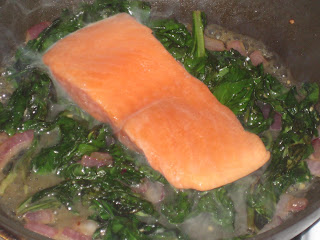We cut this recipe out of the newspaper years ago, and it is always a crowd pleaser. Duck seems like such a decadent meat, probably due to the fatty skin, and a rich marmalade really complements it nicely.
Marmalade Ingredients: 1/2 cup diced red onion, 1 tsp minced garlic, 2 large plums diced, 2 tbsp brown sugar, 1/2 cup chicken broth, 1/4 cup balsamic vinegar, salt/pepper
Begin with the marmalade since it can be made a day ahead of time, or it can sit while you cook the duck. Add your onion and garlic to a tbsp of olive oil to saute.
Once softened, add the plums. Now we had trouble finding fresh plums in November, so we went with canned plums. These work well since you're using them for a sauce as opposed to eating whole. Don't go with dried plums. We did find fresh pluots, which would also substitute nicely.
After a few minutes when everything is nice and soft now, add the brown sugar then the broth, vinegar, and salt/pepper.
One of our diners is allergic to balsamic so I cooked it with just the broth first, then once reduced, portioned some out for her and added the balsamic to the rest of the ingredients. Cook for several minutes until the sauce is very thick...like a marmalade...that's when the flavor is strongest and the broth/vinegar are reduced enough.
You can set aside the marmalade until ready to serve, or cook the duck concurrently, but if you cook the duck at the same time, make sure the duck doesn't finish before the sauce because either your duck will get cold, or you'll be forced to overcook it...neither one ideal.
For the duck, season both sides with salt and pepper, heat some butter and olive oil in a skillet and add the duck breast, skin side down to begin searing.
Cook for about 5 minutes on the skin side over medium/high heat. There may be some splatter, so feel free to cover the pot with a splatter shield, but don't cover with a lid just yet. Once you can see some of the meat above the skin cooking, flip the duck to heat the other side. Cook at this point until your desired doneness. I prefer my duck medium rare, so I char both the fat and the meat, then flip back over to the skin side and put a lid on the skillet for another 2 minutes or so to allow the heat to cook the insides.
To serve, slice each breast and fan out the pieces on the plate. If at this point you find your duck is undercooked, go ahead and place the slices back in the skillet over medium heat, but only heat on one side, so the remaining side stays pink, yet you maintain proper cooking. Spoon the marmalade over the duck or to the side. We served with rice and brussels sprouts and the marmalade tasted nice on the sides as well as the duck.














































